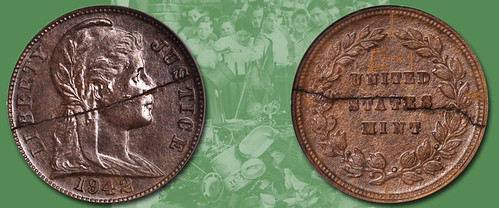
PREV ARTICLE
NEXT ARTICLE
FULL ISSUE
PREV FULL ISSUE
1942 EXPERIMENTAL CENT OFFERED
A June 8, 2016 Stack's Bowers blog article by James McCartney highlights an interesting experimental U.S. coin being offered in the
firm's August 2016 Anaheim ANA World's Fair of Money Auction. -Editor

The years during and surrounding World War II were an era of inventiveness and ingenuity among manufacturers in the United States, the result of shortages that threatened the availability of previously abundant raw materials. The Mint was not spared from this rationing, and in 1942 it began a search for materials to substitute for copper in the Lincoln cent, as copper was among the most valuable metals to the wartime effort. Independent manufacturers submitted samples of proposed substitutes, which included various metal alloys, plastics and even glass. Though the Mint ultimately decided to utilize zinc-coated steel for the 1943 cents, durability testing performed on plastic samples by the National Bureau of Standards (NSB) allowed insight as to how some of these materials might have performed if they had been chosen. It is one of these plastic pieces, Judd-2062, Pollock-4045, that will be featured in our August 2016 Official Auction of the ANA World's Fair of Money in Anaheim. Called "reddish brown plastic" by Pollock, variegated cinnamon and deep mahogany hues paint each side of this experimental cent. Though the pulp filler delivers a lightly fibrous texture, the piece remains glossy overall. The previously severed halves have been neatly united, with just the faintest traces of glue residue visible under magnification. Calculated marks are spotted at 12, 3, 6 and 9 o'clock on the reverse—likely positioning marks from the NSB tests--and the characters E-1 are engraved in the upper field. As quoted by Roger Burdette in United States Pattern & Experimental Pieces of WW-II (2012), the NSB report presented to the Bureau of the Mint on December 22, 1942 notes that specimens provided by Durez Plastics and Chemicals, Inc. were given the sample designation E, alluding to the provenance of the present example. The same report outlines an Impact Strength Test in Table 9 that evaluates a specimen "1" from sample E, employing an Izod-style test that strikes specimens until fracture. Without much imagination, it could be suggested that the present "E-1" example was severed in this U.S. Government-regulated evaluation. Burdette also plates this piece on page 171 in the aforementioned work where he notes that 50 to 100 samples of the RB 42-57 type were sent to the Mint, and at least a dozen were provided to NBS for testing. To read the complete article, see:

Wayne Homren, Editor The Numismatic Bibliomania Society is a non-profit organization promoting numismatic literature. See our web site at coinbooks.org. To submit items for publication in The E-Sylum, write to the Editor at this address: whomren@gmail.com To subscribe go to: https://my.binhost.com/lists/listinfo/esylum All Rights Reserved. NBS Home Page Contact the NBS webmaster 
|